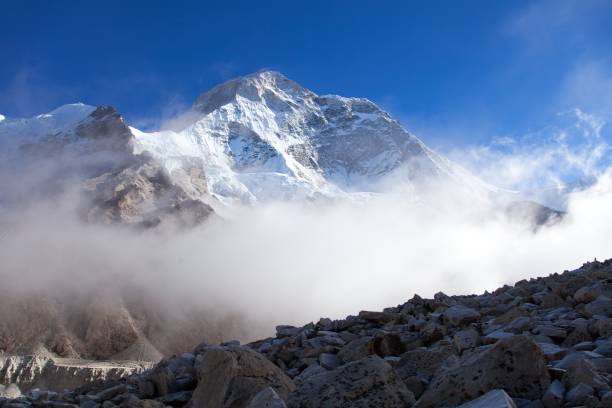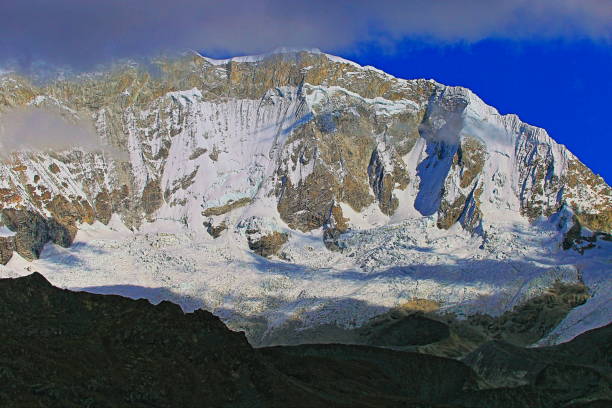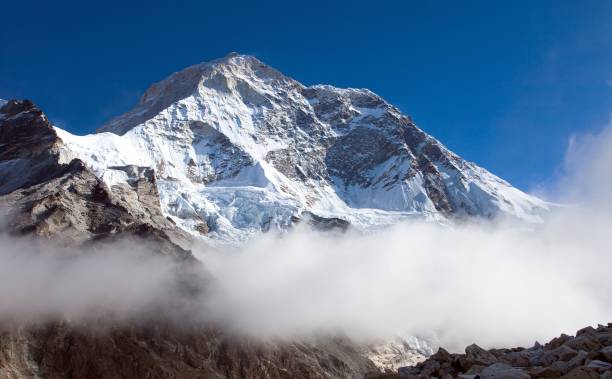Introduction to Mount Everest
Mount Everest, dubbed as the tallest mountain on the face of the earth stands majestically at 17, 280 feet on above the sea level. Overlooking the mystic range of the Himalayas, this mountain is located at the border of Nepal with the Tibet Autonomous Region of China. The culmination – man’s triumph over his own nature – attracts global tourists and climbers with the desire to conquer the last frontier on planet: the world’s highest point.
Geographically it stands on the Mahlangu range of the Great Himalayas, forming a part of the Seven Summits and is a milestone in the field of alpinism. The mountain is not only magnificent natural formation, but it is also significant as geographic location that is culturally connected to neighbors –Nepal and Tibet. The Hindus and the Buddhists recognized the peak as the god and goddess respectively, the abode of godly Sagarmatha which means the mother goddess of the world Chomolungma to the Tibetan speaking people.
Mount Everest has been an attraction to explorers in the past and has emerged to represent man’s endeavor and adventure. The mountain was originally named in the middle of the nineteenth century while the Great Trigonometrical Survey of Indian was in progress and was officially renamed after Sir George Everest, the British surveyor general. It took many attempts and trials but Sir Edmund Hillary, a New Zealander, and Tenzing Norgay, a Sherpa of Nepal would finally and officially embark on the first successful to the top of the mountain on the 29th of May in the year 1953, this created the best achievement in mountaineering.
Mount Everest is significant in cultural iconography as well in terms geography and physical structure. It is a signal that shows one the major attractions of our planet being its geological wonders, the force of the nature, and the character that is within every person. Since time immemorial, Books, documentaries together with scientific research cannot cease to explore this mountain; Even to date, most people hold a profound sense of respect for this giant mass and those associated with its conquest, this mountain stands as the highest peak on the surface of the globe hence an epitome of the adventurous spirit.
The Geographical Formation of Mount Everest
The other facility that will be highlighted is the mount Everest which is as a result considered to be the highest on the surface of earth. How this immense mountain has been produced is best explained by the multiple and active aspects of the plate tectonics. About 60MYA the Indian plate started its northward movement towards the Eurasian plate. This tectonic collision is known to have moved at a rate of about 15 centimeters per year and played a massive part in the formation of part of the Himalayan ranges, including the Mount Everest.
The contact of these enormous plates is one of a very typical convergent margin, where the India was forced upon the Eurasia in what is known as subduction zone. The tremendous pressure that built up from the impact forced the Earth’s crust to deform by folding it on itself to create a chain of mountains over millions of years – the Himalayas. These great pressures over thousands of years have extended Mount Everest to its present great height of 8,848 meters (29,029 feet) above sea level.
Mount Everest is believed to be in the region of fifty million to sixty million years old and is therefore classified under the Cenozoic group of the age of mountain formation. Nonetheless, for any wondering whether Mount Everest has been growing all these years since its formation, the answer is highly affirmative. The tectonic action is still occurring, and that means Mount Everest is still growing, around a quarter of an inch per each of the following year. Such a continuous growth is a clear indication of the constantly evolving Earth geological setting.
So, the story of formation of Mount Everest as a geographical structure is actually a dramatic story of the forces of geology acting over millions of years. The shifting of the tectonic plates, the Indian that is on the one hand and the Eurasian on the other, has given rise to the majestic heights of Mount Everest, a major factor that has added to the mountain’s charm just as much as to our understanding of Mother Nature’s tempestuous shaping forces that she continues to unleash on our planet.
Historical Attempts to Summit Mount Everest
The dream to climb Mount Everest originated with individuals from the early twentieth century, by which the peak was the highest in the Earth. The first sketch of the mountain hard terrain was made in some reconnaissance surveys conducted in the 1920s. Of all such pioneering undertakings one must mention the British Reconnaissance Expedition of 1921. It was intended to achieve reconnaissance of the area and possible paths toward the top. The next being the 1922 British Mount Everest Expedition which undertook the first directed attempts at higher altitudes and failed to smith while intentional or otherwise they set altitude records in the process.
But it took again in 1924 with a British expedition with George Mallory and Andrew ‘Sandy’ Irvine that came very close to the top. Whether or not they got a chance to step at this peak before they were last seen near the summit remains a point of discussion up to this date. This sad but famous story was aimed at showing everyone the destructive nature of the mountain, thus stressing on the harsh conditions that the climbers have to face.
It was many years before another major step was taken. This was on May 29, 1953, jointly by Sir Edmund Hillary of New Zealand and a Sherpa of Nepal Tenzing Norgay. Their iconic ascent through the super technical South Col route marked the victorious end of decades of ever continuing attempts and would inspire future generations of climbers.
The above climb was filed as history, other incredible feats on Mount Everest followed. It took up to 1963, for American climbers named Jim Whittaker and Nawang Gombo to be part of the successful climbers from their country. The first climbers to scale the peak were a Japanese Junko Tabei and Nepali Sherpa Phantom in 1975.
People climbed higher and higher, and achievements multiplied despite such risks: Reinhold Messner, and Peter Habeler made first and oxygen-free ascents in 1978. Younger climbers such as Jordan Romero, who climbed at 13 in 2010 began supplementing climbers of the past and enthusing new generations.
The fact that people tried to conquer Mount Everest for so many years and failed of course speaks volumes about human curiosity, and one’s capacity to endure the harshest conditions of nature. Every boot print seals Everest’s image in the people’s mind set, as the ultimate conquest and test.
The Challenges of Climbing Everest
Largest mountain of the world with a height of 8,848 meters, Mount Everest has numerous difficulties to offer to climbers. The vagaries of weather, one could argue, are the most conspicuous challenge herein. It has been stated that sometimes, it does freeze down to well below freezing point and the conditions change with lightning pace making the climb quite deadly. It may be halted by gales and white outs which always pose a challenge to the resilience as well as readiness of all the climbers.
Among the most noteworthy adversities climbers have to deal with, one has to acknowledge altitude sickness. With elevation, however, barometric pressure goes down and this means a considerable reduction in oxygen availability. This can bring about AMS; symptoms include headache, nausea and fatigue. Even in extreme conditions, the climbers may undergo High Altitude Pulmonary Edema and the considered fatal High Altitude Cerebral Edema both of which call for immediate descent and medical attention.
Another life hazard nature presents on this mountain is avalanches Another life hazard nature presents in this mountain is avalanches. The climber’s always stand the risk of sliding from the mountain’s slopes after developing instability especially after a heavy snow accumulation. The Khumbu Ice Fall, a glacier, located at the foot of the Western Cwm, abounds with many types of ice form and crevasses and is therefore very dangerous for all the teams involved in any expedition.
However, these are not the only physical dangers that are associated with climbing, and the pressure that is endowed by climbing Everest cannot be ignored. Fatigue, loneliness, and staying in extreme situations for long can cause a very negative impact on one’s mind. One should not only be physically fit to withstand the bodily stress of the climb but one requires steadfastness to withstand the strain that is probably emotional.
Because of the mentioned tasks, preconditions for the successful Everest expedition require enormous preparation. This entails special workouts meant for building up physical steeled muscle that will be required in the adventure, preparing to go to high altitude and also items that will be needed for the journey. Preparation also involves physical conditioning of the climbers and preparing them mentally so that they are in a position to deal with all the harsh adversities of this magnificent but unforgiving hike.
The Routes to the Summit
Mount Everest, the highest peak on Earth, presents two principal routes for climbers aiming for its summit: the South Col route which starts from the Nepal side and the other one is the Northeast Ridge route which starts from the Tibetan side. These roads contain those obstacles and important geographic features which are crucial for climbers to discern without fail.
South Col is one of the most popular routes used in the ascent to the peak. This journey starts from the base camp in Nepal, which is nearly at an altitude of 5,364 meters (17494 feet). Climbers move along the complex and steep field called Khumbu Icefall – a glacier that rarely remains the same for two consecutive hours. After this, expeditions go to the Camp I at 6,065 meters and the second camp is again in the western cwm at 6,400 meters. The second camp is located in areas with steep icy terrains, and this area is characterized by the high possibility of avalanches.
The third camp is established at Lhotse Face at an elevation of 7, 470m/ 24,500’ where the climber experience very worst wind and low oxygen. The last camp is the Camp IV is pitched on the South Col and it is situated at an elevation of 7,920 meters or 26,000 feet. From here climbers have to ascend the dangerous zone called the Death Zone where after coming through steep snow and ice slope, the Hillary Step – a nearly vertical rock face – awaits them just below the summit. Climbers reach the final milestone in the last leg which takes them to the top of Mount Komalanga whose peak looms to about 8,848 meters or 29,029 feet.
On the northeastern aspect there is the Northeast Ridge route that originates from the Tibetan base camp that lies at about 5150m ASL. Frequently, an intermediate camp precedes an assault, and Camp I is established at North Col at 7000 meters (23000 ft) high Expedition proceeds to Camp II at roughly 7800 meters (25600 ft) Acclimatization includes steep rise and rise with exposure to lethal, frigid winds to Camp III at 8300 meters (27200 ft). The last tour is marked by the difficult Second Step, the cliff on which climbers usually consider it to be the final stage before the top.
Environmental and Ethical Considerations
For this reason, Mount Everest as the world’s tallest mountain draws many climbers every year thus causing severe issues of environmental and ethics consequences. Pollution is one of the greatest pressures, affecting or having an influence on any of Earth’s ecosystems. Such traffic increase also means crowded landing sites, therefore, a buildup of wastes is evident the more the number of expeditions the more wastes are produced. Such climbers discharge a variety of wastes like oxygen bottles which are usually discarded, packs of consumed foods, and human excreta. Just for this litter, not only the exterior of the mountain has been spoiled, but there also arises fundamental difficulties in waste disposal.
These anthropogenic activities affect the subtlety of natural environment of the Himalayan region. The use of non-biodegradable materials affects the local ecosystem, provoking possible sequential changes in the bio and plant populations. More to it, the human activity takes a toll on the glaciers or ice through walking on glaciers or through climate change, leading to glacial melt affecting the water supply for the communities.
Other important factors that need to be taken into account include ethical issues in as far as Mount Everest expedition is concerned. It has a great cultural and religious importance for the indigenous Sherpa peoples. Climbers must respect these values and traditions if they are to match their counterparts in other parts of the world.

Despite the fact that Sherpas are often viewed as mere helps or advisers, they are exposed to quite a number of dangers and difficulties. They encounter more fatalities per year than the visiting climbers because they work in some of the most dangerous terrains to serve the climbers. Sherpas have to be treated fairly and paid adequately the situation of Sherpas remains vital and needs to be addressed.
Safe climbing practices include ethical practices that are more than self-serving. This involves the safety of all climbers, their training, preparation as well as doing everything to mitigate on risks and impacts to the environment. Strict compliance with the laid down rules and success in the cleanup exercises are other steps towards ensuring that the ‘Roof of the World’ remains a haven for the next generations to visit. It could be said that as the climbing population is in charge of this form of natural resource, it is their duty to encourage responsible and ‘clean’ climbing.
The Role of Sherpas in Everest Expeditions
Sherpas of Himalayan area are the first to explain climbers the way to struggle the Mount Everest, the highest mountain on the Earth. They have been involved in climbing activities from the earlier part of the twentieth century with assisting climbers such as Sir Edmund Hillary and Tenzing Norgay. Sherpas have an extraordinary familiarity with the rocks of the mountains, which alongside with their extraordinary physical fitness and acclimatization to the O2 loss at high altitude, makes Sherpas central to the dangerous climbing to the top of the Everest.
In the past, Sherpas have been culturally acknowledged for their potential for mountaineering in view of their historical predisposition to the harsh conditions of the environment of the Himalayas. This has armed them with vital knowledge on the physical features as well as the crucial aspects of climate and survival needed when climbing the slopes of ‘The Everest’. Sherpas are not only experienced climbers but act as porters as well, who transport most of the equipment and other necessities for the climb to save the time and energy of the climbers, for them hauling is the primary work of sherpa.
Sherpas are primarily Buddhists, and so their culture is entwined with mountain climbing as an activity and its etiquette. Both, reverence for nature and the concept of kami as spiritual protectors of the mountains are an essential part of their attitude towards climbing. This sort of cultural disposition provides a strong respect to Everest which is also embraced as ‘Chomolungma’ meaning ‘Goddess Mother of the World’ such beliefs support the Sherpas and climbers, providing religious perspective to the arduous undertaking.
As valuable as Sherpas are to the climbing experience, they are not without considerable danger. The environment on the Everest Mountain seeks them out potentially fatal dangers such as avalanches, frost bite and altitude sickness. The devastating avalanche in 2014 and the earthquake that ensued in 2015 showed their line of work was deadly and many Sherpa lost their lives. These events have raised the global awareness for improved safety procedures and payment for hazardous service these workers provide.
Over the years there has been the intimacy between the Sherpas and the climbers which has been characterized by the respect and the reliance in between the two parties. Yet it has to overcome some challenges, for instance, ethical issue regarding the commercialization of the Everest that has enhanced congestion with consequent effects on the environment.

Modern Day Everest: Tourism and Technology
Mount Everest which was limited to a few climbers now epitomizes a world popular climbers’ landmark. The commercialization of climbing has doubled and trebled the number of tourists, and thus, has made it both an icon of human accomplishment and an area of worry when it comes to environmental conservation. This has been made possible by a marked enhanced in technology, better gears, navigation systems as well as safety measures, to make it appealing, to many people.
In modernity, apparatus such as high-performance outer garments for climbers, over-burst oxygen containers, lightweight climbing equipment amongst others have revolutionized the experience at the Everest. New synthesized fabrics bring better protection against cold and other ambiences on the mountain, and the capacity to repel wetness. Also, the portable oxygen systems have improved over the years, and their weights reduced; thus, climbers can reduce the impact of altitude. Thanks to satellite communication devices such as GPS and Satellite phones climbers can also check the weather reliably and stay in touch with people on the ground.
Hence, the steadily growing flow of tourists has numerous advantages, but even with the development of technologies these have certain drawbacks. This is especially true when many climbers attempt to go up the routes within specific periods of the year that allow for climbing, and even where rescue is called for is difficult. Climbers have also brought in addition environmental challenges because the number has increased, and waste management is a problem. Some attempt has been made to curtail these ills such as enforcing firm condition of permits, annual clean-up campaigns, and advanced policies on disposal of wastes.
Regarding the future, all actors concerned with the site try to maintain the accessibility for tourists while at the same time ensuring the protection of Mount Everest. Measures are being taken to ensure that the economic returns are derived together with the protection of the environment through sustainable tourism. Technology remains an important factor, and there are studies on the biodegradable materials for climbing gears, and new approaches to waste disposal. As preservation strategies for Everest and other mountains are carried out, it becomes hard to balance visitors’ impulse to conquer the mountains and at the same time ensure that the beauty of the mountains is preserved in future.



